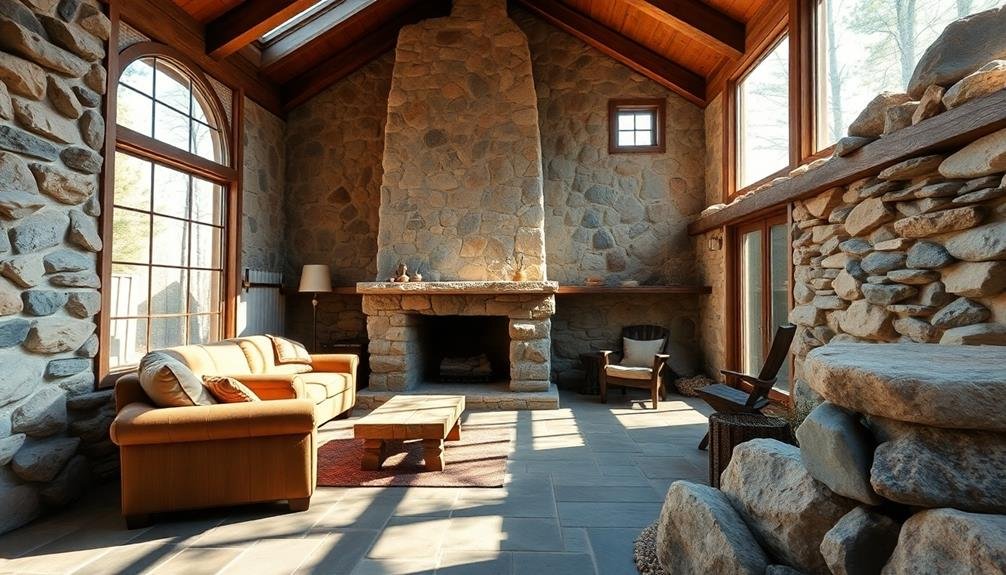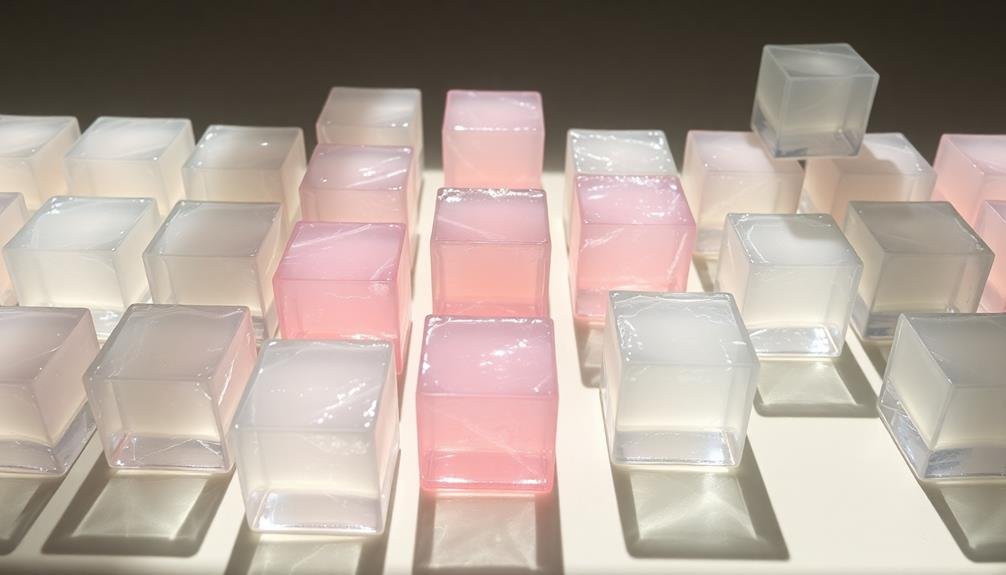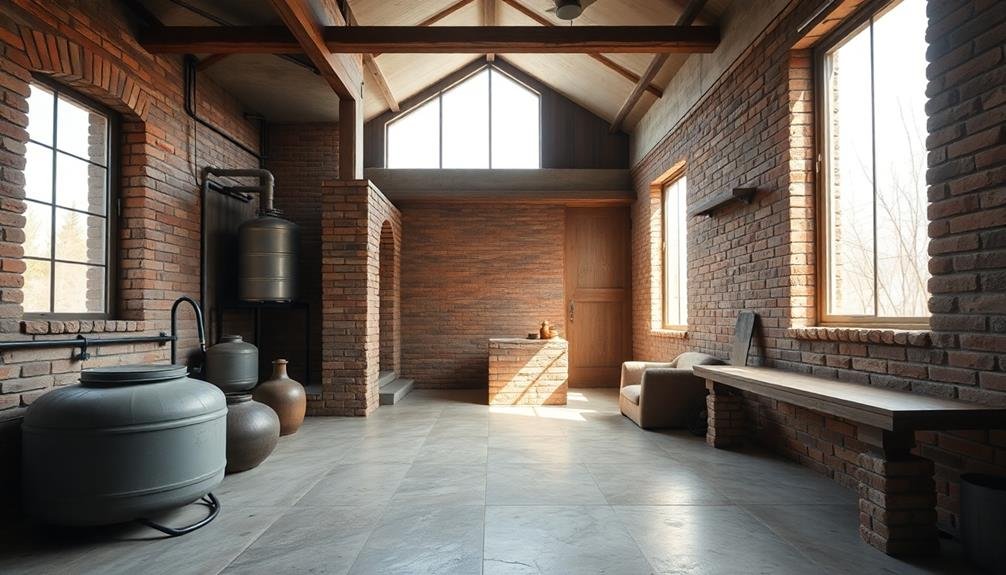You'll discover seven exceptional thermal mass materials that revolutionize off-grid temperature control. Water tops the list with its unmatched heat capacity, followed by concrete's substantial storage capabilities. Stone offers durability and natural beauty, while earth and adobe provide sustainable, cost-effective options. Brick's density excels in regulating indoor temperatures, and ceramic tiles efficiently absorb and release heat. Finally, innovative phase change materials (PCMs) offer tailored solutions for specific climate needs. Each material brings unique benefits to your off-grid living space, helping you maintain comfort year-round. Exploring these options further will reveal how to best incorporate them into your sustainable design.
Water

As a prime example of thermal mass, water stands out for its exceptional heat capacity. You'll find it absorbs and releases heat slowly, making it an ideal material for temperature regulation in off-grid settings. Water's high specific heat capacity allows it to store large amounts of thermal energy without significant temperature changes.
In off-grid homes, you can incorporate water-based thermal mass systems through various methods. Large water tanks or barrels placed in sunlit areas can absorb heat during the day and release it at night, helping to maintain a consistent indoor temperature.
You might also consider using water walls or rooftop ponds to enhance your home's thermal performance.
Water's versatility extends to its use in radiant floor heating systems, where it can efficiently distribute heat throughout your living space. Additionally, you can employ water-filled containers in greenhouses or solar rooms to stabilize temperatures and protect plants from extreme fluctuations.
When implementing water as thermal mass, guarantee proper insulation and sealing to prevent leaks and maximize efficiency.
Concrete
Concrete, another popular thermal mass material, offers substantial heat storage capabilities for off-grid temperature control. It's widely available, relatively inexpensive, and can be easily incorporated into various building elements.
You'll find that concrete's high thermal mass allows it to absorb heat during the day and release it slowly at night, helping to maintain a more stable indoor temperature.
When using concrete for thermal mass, you should consider its placement within your off-grid structure. Floors and interior walls exposed to direct sunlight are ideal locations, as they can effectively capture and store solar heat.
You can also use concrete in exterior walls, but be sure to provide proper insulation to prevent unwanted heat loss.
Keep in mind that concrete's effectiveness as a thermal mass material depends on its thickness. Generally, a 4-6 inch layer is sufficient for most applications.
You can enhance concrete's thermal properties by adding aggregates like crushed stone or incorporating phase change materials.
Remember that while concrete excels at heat storage, it may take longer to warm up or cool down compared to other materials, so plan your heating and cooling strategies accordingly.
Stone

Stone, another excellent thermal mass material, shares many benefits with concrete while offering its own unique advantages. You'll find that stone has a high heat capacity, absorbing and releasing heat slowly throughout the day. This property makes it ideal for maintaining stable temperatures in off-grid structures.
Unlike concrete, stone comes in various natural forms, allowing you to choose from options like granite, limestone, or slate. Each type has slightly different thermal properties, giving you flexibility in your design. Stone's durability guarantees that it'll last for generations, making it a sustainable choice for long-term temperature control.
You can incorporate stone into your off-grid home through thick walls, flooring, or strategically placed interior features. Its aesthetic appeal is an added bonus, as you can create visually striking spaces while harnessing its thermal benefits. Stone's ability to regulate humidity also contributes to a comfortable indoor environment.
When using stone, consider its weight and the structural support required. You'll need to plan carefully for proper installation, but the long-term benefits in temperature control and energy savings make it a worthwhile investment for your off-grid home.
Earth and Adobe
Earthen materials, including adobe, stand out from among the most ancient and effective thermal mass options for off-grid temperature control.
You'll find these materials readily available in many regions, making them cost-effective choices for sustainable building. Adobe, a mixture of clay, sand, and straw, has been used for centuries in hot, arid climates due to its excellent thermal properties.
When you use earth or adobe in your walls or floors, you're tapping into their ability to absorb heat during the day and release it slowly at night.
This natural temperature regulation can greatly reduce your reliance on artificial heating and cooling systems. Earth's high density and specific heat capacity allow it to store large amounts of thermal energy, helping maintain a stable indoor temperature.
You can incorporate earthen materials in various ways, from rammed earth walls to adobe bricks or even earthbag construction.
These methods not only provide thermal mass but also offer soundproofing and fire-resistant properties.
Brick

Moving from earthen materials, we find another popular and effective thermal mass option: brick. You'll find that brick has been used for centuries in construction due to its durability and thermal properties. When incorporated into your off-grid home, brick can considerably contribute to temperature regulation.
Brick's high density allows it to absorb heat slowly during the day and release it gradually at night, helping to maintain a stable indoor temperature. You'll appreciate its ability to reduce temperature fluctuations, keeping your living space cooler in summer and warmer in winter.
Brick walls, floors, or even standalone features like a brick fireplace can serve as excellent thermal mass elements. You can maximize brick's effectiveness by placing it in areas that receive direct sunlight or near heat sources.
Remember that darker-colored bricks absorb more heat than lighter ones. While brick requires a higher initial investment than some other materials, its longevity and low maintenance needs make it cost-effective in the long run.
Consider combining brick with other thermal mass materials for ideal temperature control in your off-grid home.
Ceramic Tiles
Ceramic tiles offer another excellent option for thermal mass in your off-grid home. They're dense, durable, and have a high heat capacity, making them ideal for storing and releasing thermal energy.
You'll find ceramic tiles particularly effective in areas that receive direct sunlight, as they can absorb heat during the day and release it slowly at night.
When using ceramic tiles for thermal mass, consider installing them on floors or walls where they'll be exposed to sunlight or radiant heat sources. Darker colors will absorb more heat, while lighter shades can help reflect light and heat in warmer climates.
The thickness of the tiles also matters; thicker tiles will store more heat but take longer to warm up and cool down.
Ceramic tiles are versatile and come in various sizes, shapes, and finishes. You can easily incorporate them into your home's design while benefiting from their thermal properties.
They're also low-maintenance and easy to clean, making them a practical choice for off-grid living. When combined with proper insulation and ventilation, ceramic tiles can greatly contribute to maintaining a comfortable temperature in your home year-round.
Phase Change Materials

Have you ever wondered about materials that can store and release heat at specific temperatures? Phase change materials (PCMs) are innovative thermal mass solutions that do just that. Unlike traditional thermal mass materials, PCMs absorb and release heat at a constant temperature as they change from solid to liquid and back.
You'll find PCMs particularly useful in off-grid temperature control systems. They can absorb excess heat during the day and release it at night, helping maintain a comfortable indoor temperature. Common PCMs include paraffin wax, salt hydrates, and fatty acids. Each type has its own melting point, allowing you to choose the best option for your climate.
PCMs can be incorporated into building materials like drywall, concrete, or insulation. You can also use them in standalone units or as part of a hydronic heating system. Their high energy storage capacity means you'll need less material compared to traditional thermal mass options.
However, keep in mind that PCMs can be more expensive and may require special containment to prevent leakage. Consider your specific needs and budget when deciding if PCMs are the right choice for your off-grid temperature control system.
Frequently Asked Questions
How Does Thermal Mass Differ From Insulation in Temperature Control?
Thermal mass absorbs and stores heat, while insulation slows heat transfer. You'll find that thermal mass regulates temperature by releasing stored heat gradually, whereas insulation creates a barrier to maintain temperature differences between spaces.
Can Thermal Mass Materials Be Effectively Combined for Better Performance?
Yes, you can combine thermal mass materials for better performance. You'll get enhanced heat storage and temperature regulation by layering different materials. Try pairing dense materials like concrete with phase change materials for ideal results in your temperature control system.
What Maintenance Is Required for Thermal Mass Systems in Off-Grid Homes?
You'll need to inspect your thermal mass system regularly. Check for cracks, moisture issues, and proper insulation. Clean surfaces to maintain efficiency. Guarantee proper ventilation and air circulation. You may need to recharge or replace certain materials periodically.
How Do Climate Zones Affect the Choice of Thermal Mass Materials?
Climate zones greatly impact your thermal mass material choices. You'll want dense materials in hot climates to absorb heat, while lightweight options work better in cold areas. Consider your specific region's temperature swings when selecting materials.
Are There Any Health Concerns Associated With Using Certain Thermal Mass Materials?
You should be aware that some thermal mass materials can pose health risks. Asbestos and certain types of concrete may release harmful particles. It's essential to research and choose safe options for your living space.
In Summary
You've now explored seven excellent thermal mass materials for off-grid temperature control. Whether you choose water, concrete, stone, earth, brick, ceramic tiles, or phase change materials, you're on the right track to creating a more energy-efficient living space. Remember, each material has its unique benefits, so consider your specific needs and climate when making your selection. By incorporating these materials, you'll enjoy more stable temperatures and reduced energy costs year-round.





Leave a Reply